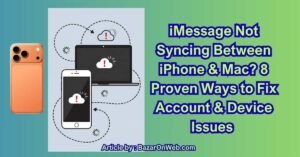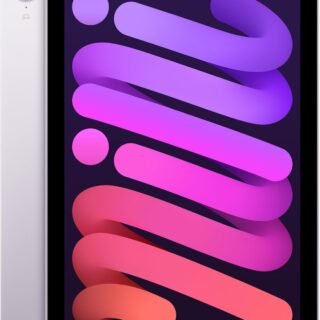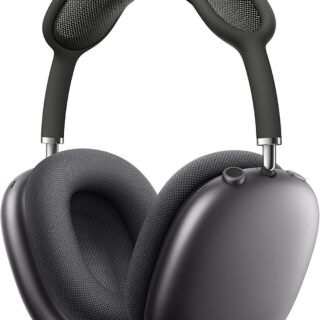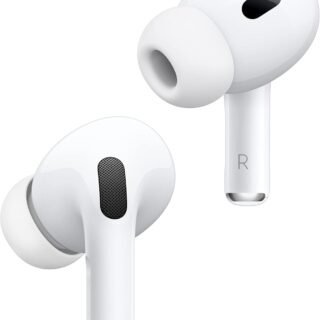Category
Popular Articles
- AI (12)
- Android (38)
- App Suggest (4)
- Apple (15)
- Apple TV (2)
- Bluetooth (3)
- Cars (2)
- ChatGpt (1)
- Chrome (2)
- Did you know? (1)
- E-Commerce News (1)
- Ecommerce Websites business (7)
- Electronics Shopping (5)
- Fashion Tips (3)
- Gaming (4)
- Google Gemini (3)
- Hair Care Tips (2)
- How to (13)
- iCloud (1)
- Infotainment System (1)
- Iphone (101)
- Job Posting (1)
- Lifestyle (3)
- Mac (20)
- Mobile Games (1)
- Netflix (1)
- Online Shopping Websites (2)
- Personal Finance Management (3)
- Product Reviews (3)
- Roku TV (4)
- Samsung (9)
- Shopping Tips (10)
- Spotify (1)
- Tech (92)
- Windows 11 (18)
- Zero Waste (3)
Discounted Products
-
 Leo Creation 144 TC Cotton Double Jaipuri Prints Flat Bedsheet(Pack of 1, Blue, Gree, Red, Grey, Light Grey)
Leo Creation 144 TC Cotton Double Jaipuri Prints Flat Bedsheet(Pack of 1, Blue, Gree, Red, Grey, Light Grey)
₹2,999.00Original price was: ₹2,999.00.₹329.00Current price is: ₹329.00. -
 Home Garage 210 TC Cotton King Floral Fitted (Elastic) Bedsheet(Pack of 1, Grey)
Home Garage 210 TC Cotton King Floral Fitted (Elastic) Bedsheet(Pack of 1, Grey)
₹999.00Original price was: ₹999.00.₹299.00Current price is: ₹299.00. -
 Goodrik 140 TC Cotton Double 3D Printed Flat Bedsheet(Pack of 1, Brown)
Goodrik 140 TC Cotton Double 3D Printed Flat Bedsheet(Pack of 1, Brown)
₹499.00Original price was: ₹499.00.₹229.00Current price is: ₹229.00. -
 GLOBALSHOP 350 TC Microfiber Double Floral Flat Bedsheet(Pack of 1, Multicolor)
GLOBALSHOP 350 TC Microfiber Double Floral Flat Bedsheet(Pack of 1, Multicolor)
₹1,250.00Original price was: ₹1,250.00.₹263.00Current price is: ₹263.00. -
 RisingStar 250 TC Microfiber King Printed Fitted (Elastic) Bedsheet(Pack of 1, FITTED-ROUND-CIRCLES-PREMIUM)
RisingStar 250 TC Microfiber King Printed Fitted (Elastic) Bedsheet(Pack of 1, FITTED-ROUND-CIRCLES-PREMIUM)
₹2,299.00Original price was: ₹2,299.00.₹299.00Current price is: ₹299.00. -
 Home Garage 210 TC Cotton King Floral Fitted (Elastic) Bedsheet(Pack of 1, Fitted Black Green)
Home Garage 210 TC Cotton King Floral Fitted (Elastic) Bedsheet(Pack of 1, Fitted Black Green)
₹1,299.00Original price was: ₹1,299.00.₹299.00Current price is: ₹299.00. -
 Home Garage 180 TC Cotton King 3D Printed Flat Bedsheet(Pack of 1, White)
Home Garage 180 TC Cotton King 3D Printed Flat Bedsheet(Pack of 1, White)
₹999.00Original price was: ₹999.00.₹229.00Current price is: ₹229.00. -
 Home Sizzler 153 cm (5 ft) Polyester Room Darkening Window Curtain (Pack Of 2)(Floral, Maroon)
Home Sizzler 153 cm (5 ft) Polyester Room Darkening Window Curtain (Pack Of 2)(Floral, Maroon)
₹799.00Original price was: ₹799.00.₹299.00Current price is: ₹299.00. -
 Panipat Textile Hub 152.4 cm (5 ft) Polyester Window Curtain (Pack Of 2)(Solid, Aqua)
Panipat Textile Hub 152.4 cm (5 ft) Polyester Window Curtain (Pack Of 2)(Solid, Aqua)
₹1,899.00Original price was: ₹1,899.00.₹299.00Current price is: ₹299.00. -
 Home Sizzler 214 cm (7 ft) Polyester Semi Transparent Door Curtain (Pack Of 2)(Floral, Maroon)
Home Sizzler 214 cm (7 ft) Polyester Semi Transparent Door Curtain (Pack Of 2)(Floral, Maroon)
₹1,199.00Original price was: ₹1,199.00.₹399.00Current price is: ₹399.00. -
 Home Sizzler 153 cm (5 ft) Polyester Room Darkening Window Curtain (Pack Of 2)(Floral, Brown)
Home Sizzler 153 cm (5 ft) Polyester Room Darkening Window Curtain (Pack Of 2)(Floral, Brown)
₹799.00Original price was: ₹799.00.₹299.00Current price is: ₹299.00. -
 Stella Creations 214 cm (7 ft) Polyester Room Darkening Door Curtain (Pack Of 2)(Abstract, Brown)
Stella Creations 214 cm (7 ft) Polyester Room Darkening Door Curtain (Pack Of 2)(Abstract, Brown)
₹1,299.00Original price was: ₹1,299.00.₹449.00Current price is: ₹449.00. -
 Homefab India 152.5 cm (5 ft) Polyester Room Darkening Window Curtain (Pack Of 2)(Floral, Light Blue)
Homefab India 152.5 cm (5 ft) Polyester Room Darkening Window Curtain (Pack Of 2)(Floral, Light Blue)
₹1,199.00Original price was: ₹1,199.00.₹319.00Current price is: ₹319.00. -
 Urban Home 214 cm (7 ft) PVC Transparent Door Curtain Single Curtain(Solid, Off White)
Urban Home 214 cm (7 ft) PVC Transparent Door Curtain Single Curtain(Solid, Off White)
₹699.00Original price was: ₹699.00.₹203.00Current price is: ₹203.00. -
 Panipat Textile Hub 213 cm (7 ft) Polyester Door Curtain (Pack Of 2)(Solid, Brown)
Panipat Textile Hub 213 cm (7 ft) Polyester Door Curtain (Pack Of 2)(Solid, Brown)
₹1,199.00Original price was: ₹1,199.00.₹349.00Current price is: ₹349.00.
Affiliate Links
Promotion

Apple’s iPhone has always been a leader in innovation, combining cutting-edge technology with sleek design. With every new generation, Apple introduces features that make life more convenient. Recently, one of the most interesting topics floating around is whether iPhones can charge each other. You may have seen videos on social media showing one phone charging another or read rumors about Apple planning to add reverse wireless charging. But how much of that is true? Can your iPhone really charge another iPhone?
In this blog, I’ll walk you through everything you need to know: whether iPhones can share power, how reverse charging works, alternative ways to charge other devices, and what Apple might have planned for the future.
Understanding the Concept of Phone-to-Phone Charging
Before we dive into Apple’s ecosystem, let’s talk about the general idea of phone-to-phone charging. This feature is also known as reverse wireless charging or power sharing. It allows one smartphone to act as a wireless charging pad for another.
Several Android manufacturers, like Samsung and Huawei, already support this feature. For example, Samsung calls it Wireless PowerShare, and it lets Galaxy phones charge other Qi-enabled devices like earbuds, smartwatches, or even another phone.
So, naturally, iPhone users are wondering: When will Apple add this feature?
Can iPhones Charge Each Other Directly?
The short answer is: No, iPhones cannot currently charge each other directly.
As of 2025, even the latest iPhone 17 lineup does not allow you to place one iPhone on the back of another to transfer battery power. While Apple has developed advanced wireless charging technology (MagSafe) and has patents related to reverse charging, the feature hasn’t been made available yet for iPhone-to-iPhone power sharing.
That said, there are a few workarounds and related technologies you can use to achieve similar results.
MagSafe and Wireless Charging Capabilities
Apple introduced MagSafe with the iPhone 12. This magnetic system aligns your iPhone perfectly with compatible wireless chargers, making charging more efficient. While MagSafe does allow accessories like power banks to attach and charge wirelessly, it does not allow one iPhone to charge another directly.
However, here’s an interesting point: in 2021, Bloomberg reported that Apple was internally testing reverse wireless charging capabilities. Some tech analysts believe Apple has the hardware built into iPhones but hasn’t enabled it yet due to efficiency and heat concerns.
So while you can’t charge your friend’s iPhone with yours right now, the possibility for the future is strong.
Can iPhones Charge Other Apple Devices?
Here’s where things get a little more promising. While you can’t use one iPhone to charge another, iPhones can charge smaller Apple accessories with the right setup.
For example:
- Some iPads with USB-C ports can charge your iPhone.
- Apple allows MagSafe Battery Pack or third-party MagSafe accessories to charge AirPods wirelessly while attached to your iPhone.
- Rumors suggest that future iPhones may extend this capability to Apple Watch charging as well.
So, while iPhones don’t yet charge other iPhones, they are moving toward being multi-device charging hubs.
Workarounds: How to Share Power Between iPhones
If you still want to “share” power between two iPhones, there are indirect ways to do it:
1. Using a MagSafe Battery Pack
Apple’s official MagSafe Battery Pack attaches magnetically to the back of your iPhone. If one of you has it, you can swap it between phones when needed. While it’s not iPhone-to-iPhone charging, it’s a practical solution when you’re traveling.
2. Using a Dual Charging Cable
You can find third-party cables with two Lightning or USB-C connectors. If you connect both iPhones to a portable power bank, they’ll charge simultaneously. This setup mimics power-sharing, although it doesn’t technically draw power from one phone to the other.
3. Charging via iPad or MacBook
Some iPads with USB-C can reverse-charge smaller devices, including iPhones. Similarly, a MacBook can charge an iPhone via USB-C. If you’re in a pinch, this could help.
Why Apple Hasn’t Added iPhone-to-iPhone Charging Yet
There are a few reasons why Apple hasn’t released this feature:
- Battery Efficiency – Reverse wireless charging isn’t as efficient as wired charging. A lot of power is lost during the transfer. Apple prefers optimized, reliable solutions.
- Heat Management – Wireless charging generates heat, and charging one phone with another would double the strain. iPhones are designed to avoid overheating, so Apple might be cautious here.
- User Experience – Apple is famous for rolling out features only when they feel polished. They might be waiting until reverse charging is seamless enough to justify the battery trade-off.
- MagSafe Ecosystem – Apple already has a lucrative accessory ecosystem built around MagSafe. They may want to prioritize accessories like the MagSafe Battery Pack before enabling iPhone-to-iPhone charging.
Future of iPhone-to-iPhone Charging
Even though the feature isn’t available now, there’s a strong chance Apple will introduce reverse wireless charging in the near future. Analysts predict that iPhones could eventually:
- Charge each other wirelessly.
- Provide power to AirPods and Apple Watch directly from the iPhone’s back.
- Serve as emergency chargers for smaller gadgets.
This would make the iPhone not just a communication device but a power hub for your Apple ecosystem.
Pros and Cons of iPhone-to-iPhone Charging (If It Arrives)
✅ Pros
- Share battery in emergencies.
- No need to carry extra chargers.
- Helps when traveling with multiple devices.
- Adds convenience for Apple’s ecosystem.
❌ Cons
- Could drain your iPhone quickly.
- Inefficient compared to wired charging.
- May generate extra heat.
- Not ideal for long-term or frequent use.
So, can iPhones charge each other? Not yet. As of today, there is no way to directly share power from one iPhone to another. But Apple’s advancements in MagSafe and wireless charging suggest that this feature may be coming in the future.
In the meantime, if you’re looking to share battery power, the best options are carrying a MagSafe Battery Pack, portable charger, or using iPads and MacBooks with USB-C reverse charging.
Until Apple finally enables reverse wireless charging on iPhones, those solutions remain your best bet. But when that day comes, the iPhone will take another giant leap toward being the ultimate all-in-one device.
Written by Bazaronweb
Latest Tech Articles
- 5 Ways to Backup and Restore Registry Settings in Windows

- iMessage Not Syncing Between iPhone & Mac? 8 Proven Ways to Fix Account & Device Issues

- Outlook Not Receiving Emails? 8 Proven Fixes for Windows, Mac & Mobile

- Zoom Not Connecting? 7 Ways to Fix Meeting Join Errors on Windows & Mac

- Microsoft Teams Not Opening? 5 Proven Fixes to Restart Your Workspace

Products
-
![Apple Watch Ultra 3 [GPS + Cellular 49mm] Running & Multisport Smartwatch w/Rugged Titanium Case w/Black Titanium Milanese Loop - M. Satellite Communications, Advanced Health & Fitness Tracking](https://bazaronweb.com/retailstores/wp-content/uploads/2025/09/apple-watch-320x320.jpg) Apple Watch Ultra 3 [GPS + Cellular 49mm] Running & Multisport Smartwatch w/Rugged Titanium Case w/Black Titanium Milanese Loop - M. Satellite Communications, Advanced Health & Fitness Tracking
Apple Watch Ultra 3 [GPS + Cellular 49mm] Running & Multisport Smartwatch w/Rugged Titanium Case w/Black Titanium Milanese Loop - M. Satellite Communications, Advanced Health & Fitness Tracking
-
 Apple iPad mini (A17 Pro): Apple Intelligence, 8.3-inch Liquid Retina Display, 256GB, Wi-Fi 6E, 12MP Front/12MP Back Camera, Touch ID, All-Day Battery Life — Purple
Apple iPad mini (A17 Pro): Apple Intelligence, 8.3-inch Liquid Retina Display, 256GB, Wi-Fi 6E, 12MP Front/12MP Back Camera, Touch ID, All-Day Battery Life — Purple
-
 Apple AirPods Max Wireless Over-Ear Headphones, Active Noise Cancelling, Transparency Mode, Personalized Spatial Audio, Dolby Atmos, Bluetooth Headphones for iPhone – Space Gray
Apple AirPods Max Wireless Over-Ear Headphones, Active Noise Cancelling, Transparency Mode, Personalized Spatial Audio, Dolby Atmos, Bluetooth Headphones for iPhone – Space Gray
-
 Apple AirPods Pro 2 Wireless Earbuds, Active Noise Cancellation, Hearing Aid Feature, Bluetooth Headphones, Transparency, Personalized Spatial Audio, High-Fidelity Sound, H2 Chip, USB-C Charging
Apple AirPods Pro 2 Wireless Earbuds, Active Noise Cancellation, Hearing Aid Feature, Bluetooth Headphones, Transparency, Personalized Spatial Audio, High-Fidelity Sound, H2 Chip, USB-C Charging
-
 Leo Creation 144 TC Cotton Double Jaipuri Prints Flat Bedsheet(Pack of 1, Blue, Gree, Red, Grey, Light Grey)
Leo Creation 144 TC Cotton Double Jaipuri Prints Flat Bedsheet(Pack of 1, Blue, Gree, Red, Grey, Light Grey)
₹2,999.00Original price was: ₹2,999.00.₹329.00Current price is: ₹329.00.
Leave a Reply